By Eric Vandenbroeck and co-workers
Iran’s Regional Position Is Crumbling
A day after Iran
launched some 200 ballistic missiles at targets across the country, Israeli
officials on Oct. 2 announced plans for major retaliation, potentially against
Iranian oil production and nuclear facilities. U.S. national security adviser
Jake Sullivan similarly warned Tehran of “severe consequences,” as Washington
said it would support Israel’s response. Separately, Israel started a ground
offensive in southern Lebanon to drive Hezbollah fighters north of the Litani River.
Iran’s missile
barrage – its second against Israel in six months – came only days after an
Israeli airstrike in Beirut killed Hezbollah chief Hassan Nasrallah. At least
half a dozen other high-ranking figures in the group have died in Israeli
airstrikes in a little over a week.
Israel’s decimation
of Hezbollah’s leadership and war-making capabilities has paved the way for a
massive altering of the geopolitical landscape in the Middle East. After
decades on the offensive, Iran has suffered a huge setback in its strategy for
the region. Not only is Tehran facing a regional reversal, but its position at
home is also vulnerable given its direct confrontation with Israel. These
developments have created a historic opportunity for the United States, Turkey
and, to a lesser extent, the Arab states to roll back the disproportionate
influence that Iran has built over the past four decades.
Knockout Blow
Hezbollah has never
been so weakened. Founded in the early 1980s, the group developed into the
dominant force in Lebanon, stronger even than the Lebanese armed forces. In
2000, it forced Israel to withdraw from southern Lebanon after an 18-year
occupation. Six years later, it reaffirmed its military prowess when it battled
Israel to a stalemate. So impressive were the group’s achievements that Iran
made it the foundation of its regional strategy. Tehran modeled its armed
proxies in Iraq, Syria and Yemen after Hezbollah, which became Iran’s junior
partner in the cultivation of its proxy network.

The damage to the
group’s military capabilities and the destruction of multiple levels of its
leadership are thus systemic blows to Iran’s regional sphere of influence and
national security. With Hezbollah threatening Israel’s northern flank, Iran
could implement an aggressive foreign policy in the Arab world and advance its
nuclear program without much threat of an Israeli attack.
For the same reason,
Israel determined that the key to countering its strategic encirclement by
Iranian proxies was to cripple Hezbollah. An opportunity to execute its plans
developed over the past year, in the wake of Hamas’ Oct. 7 attack. As Israeli
forces swept through Gaza, bent on Hamas’ annihilation, Iran coordinated with
its proxies to drain Israel’s resources while enhancing Tehran’s own position.
While the Yemen-based Houthis disrupted
commercial shipping with drones and missiles, Hezbollah lobbed rockets and artillery at Israel’s
northern townships.
With its Gaza
operation ongoing, the Israeli leadership shifted its focus to the northern
front, accelerating its attacks against Hezbollah. For months, Israel had been
increasingly eliminating Hezbollah leaders and Iranian military commanders, but
the turning point came last month when it detonated thousands of pagers and
walkie-talkies used by the group and took out much of its senior military
leadership in airstrikes. The Israeli campaign culminated last Friday with an
airstrike on Hezbollah’s command bunker that killed the group’s leader of 32
years, Hassan Nasrallah, under whose leadership Hezbollah became the formidable
force it is known as today.
On Tuesday, Israel
launched a ground incursion into southern Lebanon, initially declaring its
intent to push Hezbollah away from the border. However, likely due to its early
success, Israel enlarged its goals. It now wants to translate Hezbollah’s
military losses into political weakening, creating an opportunity for
Hezbollah’s opponents to rise up and limit the group's power. If Israel is
successful, it could spell the demise of Iran’s regional strategy, but it also
risks sparking a civil war in Lebanon, which is no stranger to internal
conflict.
Domino Effect
Hezbollah’s weakening
has significant implications for Syria. Since 2011, Hezbollah and Iran have
been crucial in propping up Bashar Assad’s regime. However, Assad has kept his
distance from the current Israel-Hezbollah conflict, focusing instead on mending
ties with Arab states and Turkey. He recognizes his overreliance on Iran and
Hezbollah, especially after the Syrian civil war, and sees Russia, his other
key ally, weakening due to the Ukraine war. Assad will try to manage the
situation in Lebanon carefully to prevent it from destabilizing his fragile
regime. A weakened Hezbollah and Iran could embolden Syrian rebel groups, a
threat Assad wants to avoid. Meanwhile, Turkey, historically checked by Iranian
influence in Iraq and the Levant, will likely seek to expand its influence.
The situation marks a
severe setback for Iran, jeopardizing its four-decade effort to build a sphere
of influence from Tehran to the Eastern Mediterranean. After the events of the
past few days, that is the least of Tehran’s worries. Iran now faces the threat
of imminent and unprecedented Israeli strikes on its territory and new
revelations about the regime’s weakness. Multiple rounds of tit-for-tat strikes
are possible, even if the distance between Israel and Iran makes a sustained
direct war unlikely.
Iran is far weaker than Israel and stands to lose more
in such a conflict. One of Tehran's main concerns is that a conflict could
destabilize the country as the regime approaches a historic
leadership transition.
However, if Israel’s retaliation is extensive, the conflict could spill over
into the Gulf and potentially involve the United States. Though the situation
remains fluid, what is certain is that Iran, after some four decades as an
ascendant regional power, is now in sharp decline.
For updates click hompage here